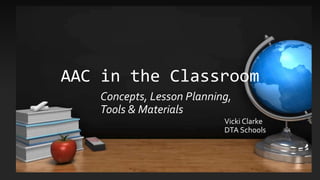AAC in the Classroom Lesson Planning, Tools & Materials
- 1. AAC in the Classroom Vicki Clarke DTA Schools Concepts, Lesson Planning, Tools & Materials
- 2. Key Concepts in AAC Implementation Core Word Learning Aided Language Input Pre-Stored Messages Fringe Vocabulary
- 3. Key Concepts: Core Word Learning
- 4. What Can You Say with Core Words?What Can You Say With Core Words?
- 5. Structured Teaching of Core Vocabulary
- 6. Use your new word! Teacher Modeling
- 7. Core in the Classroom
- 8. Resources for Teaching Core Words Project-Core.com
- 9. Tobii Dynavox Resources www.boardmakeronline.com www.tobiidynavox.com ?2017 Tobii Dynavox, LLC. All rights reserved. Core First Learning: Lesson Plans, Printables Free AAC Apps for SLPs Pathways App
- 10. Language Lab- Prentke Romich https://aaclanguagelab.com/ SLP Clinical Plans Mobile Activity Plans Printable Books & Materials Cheat Sheets for Accent Devices
- 11. Books & Lesson Plans If I Teach My Dog 8 Words P T C
- 12. AssistiveWare Core Word Classroom http://coreword.assistiveware.com/
- 13. Let¡¯s See How It Works! ConversationTopics: Here & Now Chat with your partner looking over the magazine together. ConversationTopics: Tell your partner about your weekend.
- 14. Plus some SPRINKLES! Key Concept: Fringe Vocabulary ¡are the specifics of communication. With these words, you can communicate specific pieces of information: academic vocabulary, favorite places, animals, body parts, clothing items.
- 15. What are YOUR Fringe Words? My Entertainment My Hobbies My Foods & Drinks My Places My People
- 16. Key Concepts: Aided Language Input www.lcps.org/at Christopher Bugaj, YouTube Channel LoudonCounty Public Schools Assistive Technology
- 18. Key Concept: Pre-Stored Messages PreStored Messages are a way to combat the significant challenge of how SLOW communicating with AAC can be.
- 19. Let¡¯s Try It!
- 20. Pre-Stored Messages- How to Choose? Frequent Social/Needs Demands ? Greetings ? Basic Physical Needs ? Questions ? Feelings/Comments Regularly Encountered Environments ? Mealtime ? Hygiene ? Playing withToys ? Work ? Riding in the Car ? Shopping ? Reading ? Bedtime¡
- 21. What Words Should You Start With? Home Communication Project
- 22. Greetings & Social Sharing & Opinions Language Development Academic Vocabulary
- 26. Classroom Communication Project Lesson Planning
- 27. Lesson Plan: Lily¡¯s Special Star
- 30. Communication Classroom Projects: Fulton Co AT Team- Light Tech Fulton Co ATTeam
- 31. Communication Classroom Project: Modifications Bartow County & Rome City Schools
- 32. Communication Classroom Project: Core Words Bartow & Paulding Counties & Rome City Schools
- 33. Keeping AAC Available Rome City Schools
- 34. Integrating High Tech AAC Into Our Daily Routines Paulding County,Ware County & Rome City Schools
- 35. Customizable Apps & Programs for Academics
- 36. Tiny Tap
- 37. Choose It Maker 3
- 39. Bitsboard
- 40. See.Touch.Learn
- 41. Symbol Support
- 42. Epic! Library of Books
Editor's Notes
- #5: Give everyone 5 minutes to generate as many 2-3 word phrases as possible with the core word boards
- #10: Link to Pathways App
- #16: Make a list, NOW, tell your partner about your weekend using your core word board and your fringe word list.
- #19: Use caution- we don¡¯t want to have a device or book loaded down with activity pages for every possible activity the child might encounter. It can be cumbersome and difficult to navigate in the future. Instead, prestored messages should be either used for frequent environments or social demands-
- #28: Pass out blank plans









































